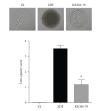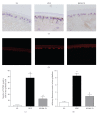KIOM-79 Prevents Lens Epithelial Cell Apoptosis and Lens Opacification in Zucker Diabetic Fatty Rats
- PMID: 20953387
- PMCID: PMC2952320
- DOI: 10.1155/2011/717921
KIOM-79 Prevents Lens Epithelial Cell Apoptosis and Lens Opacification in Zucker Diabetic Fatty Rats
Abstract
Damage of lens epithelial cells (LECs) has been implicated in cataract formation. The aim of this study was to investigate the protective effect of KIOM-79, a combination of four plant extracts, on LECs. We examined the levels of advanced glycation end products (AGEs), nuclear factor-kappaB (NF-κB) activation and inducible nitric oxide synthase (iNOS) expression in LECs during cataract development using the Zucker diabetic fatty (ZDF) rat, an animal model of type 2 diabetes. KIOM-79 was orally administered by gavage to ZDF rats once a day for 13 weeks. Apoptosis was detected by TUNEL assay, and NF-κB activation and iNOS expression were studied by southwestern histochemistry and immunohistochemistry, respectively. In diabetic cataractous lenses, TUNEL-positive LECs were markedly increased 20-fold, and AGEs were highly accumulated (2.7-fold) in LECs. In addition, both NF-κB activation, and iNOS expression were significantly enhanced 3- to 5-fold, respectively, compared to levels found in normal ZL rats. However, the administration of KIOM-79 delayed the development of diabetic cataracts and prevented LEC apoptosis (70%) through the inhibition of AGEs, NF-κB-activation and iNOS expression. These observations suggest that KIOM-79 is useful in inhibiting diabetic cataractogenesis and acts through an antiapoptotic mechanism to protect LECs from injury.
Figures






Similar articles
-
Lens epithelial cell apoptosis initiates diabetic cataractogenesis in the Zucker diabetic fatty rat.Graefes Arch Clin Exp Ophthalmol. 2010 Jun;248(6):811-8. doi: 10.1007/s00417-010-1313-1. Epub 2010 Feb 17. Graefes Arch Clin Exp Ophthalmol. 2010. PMID: 20162295
-
Combination of Medicinal Herbs KIOM-79 Reduces Advanced Glycation End Product Accumulation and the Expression of Inflammatory Factors in the Aorta of Zucker Diabetic Fatty Rats.Evid Based Complement Alternat Med. 2011;2011:784136. doi: 10.1155/2011/784136. Epub 2011 Feb 15. Evid Based Complement Alternat Med. 2011. PMID: 21350611 Free PMC article.
-
Accumulation of argpyrimidine, a methylglyoxal-derived advanced glycation end product, increases apoptosis of lens epithelial cells both in vitro and in vivo.Exp Mol Med. 2012 Feb 29;44(2):167-75. doi: 10.3858/emm.2012.44.2.012. Exp Mol Med. 2012. PMID: 22139526 Free PMC article.
-
Biomarkers of oxidative stress and cataract. Novel drug delivery therapeutic strategies targeting telomere reduction and the expression of telomerase activity in the lens epithelial cells with N-acetylcarnosine lubricant eye drops: anti-cataract which helps to prevent and treat cataracts in the eyes of dogs and other animals.Curr Drug Deliv. 2014;11(1):24-61. doi: 10.2174/15672018113106660062. Curr Drug Deliv. 2014. PMID: 24783234 Review.
-
[The oxidative stress in the cataract formation].Nippon Ganka Gakkai Zasshi. 1995 Dec;99(12):1303-41. Nippon Ganka Gakkai Zasshi. 1995. PMID: 8571853 Review. Japanese.
Cited by
-
Medicinal Plants and Natural Products Used in Cataract Management.Front Pharmacol. 2019 Jun 13;10:466. doi: 10.3389/fphar.2019.00466. eCollection 2019. Front Pharmacol. 2019. PMID: 31263410 Free PMC article. Review.
-
Saffron's protective role against atherosclerosis-induced cataract progression in New Zealand white rabbits with phytochemical analysis of saffron's extract.PLoS One. 2025 Jan 14;20(1):e0315178. doi: 10.1371/journal.pone.0315178. eCollection 2025. PLoS One. 2025. PMID: 39808674 Free PMC article.
-
Pharmacological control of receptor of advanced glycation end-products and its biological effects in psoriasis.Int J Biomed Sci. 2013 Sep;9(3):112-22. Int J Biomed Sci. 2013. PMID: 24170986 Free PMC article.
-
Diabetic complications in obese type 2 diabetic rat models.Exp Anim. 2014;63(2):121-32. doi: 10.1538/expanim.63.121. Exp Anim. 2014. PMID: 24770637 Free PMC article. Review.
-
Effectiveness of Magnolol, a Lignan from Magnolia Bark, in Diabetes, Its Complications and Comorbidities-A Review.Int J Mol Sci. 2021 Sep 17;22(18):10050. doi: 10.3390/ijms221810050. Int J Mol Sci. 2021. PMID: 34576213 Free PMC article. Review.
References
-
- Kyselova Z, Stefek M, Bauer V. Pharmacological prevention of diabetic cataract. Journal of Diabetes and Its Complications. 2004;18(2):129–140. - PubMed
-
- Ramana KV, Friedrich B, Bhatnagar A, Srivastava SK. Aldose reductase mediates cytotoxic signals of hyperglycemia and TNF-alpha in human lens epithelial cells. FASEB Journal. 2003;17(2):315–317. - PubMed
-
- Hightower KR, Reddan JR, McCready JP, Dziedzic DC. Lens epithelium: a primary target of UVB irradiation. Experimental Eye Research. 1994;59(5):557–564. - PubMed
-
- Ahmed N. Advanced glycation endproducts—role in pathology of diabetic complications. Diabetes Research and Clinical Practice. 2005;67(1):3–21. - PubMed
LinkOut - more resources
Full Text Sources

